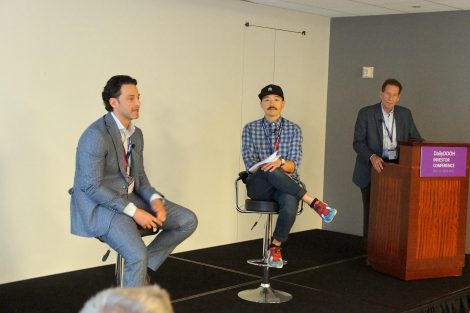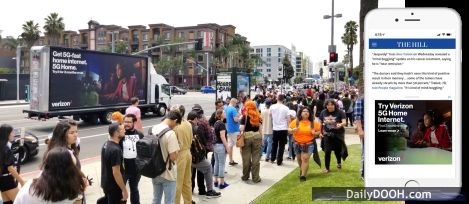Adrian J Cotterill, Editor-in-Chief
do it outdoors media, in partnership with Blue Bite, have further enhanced their fleet of mobile billboards and is now offering shadowfencing to advertisers who are looking to reinforce the OOH message digitally.

Shadowfencing is a dynamic geofence that ‘shadows’ the mobile billboard wherever it drives. The mobile billboard unit’s GPS data automatically changes the digital campaign’s targeting parameters to serve ads within 200 meters of the mobile billboard in real-time. A five-minute trail continues to serve ads to those who just viewed the mobile billboard.
Regis Maher, president and co-founder of do it outdoors media told us “This is a proprietary targeting system that Blue Bite developed for out-of-home media that moves,” says This allows our mobile fleet of advertising vehicles to offer the same digital integration as other OOH media formats, but only better. Our core advantage is our ability to move to the specific audience an advertiser wants to target, improving on relevancy and quality.”
In addition to mobile billboards, Blue Bite’s Blue Comet software, which fuels do it outdoors’s shadowfencing, has also been integrated into Vector Media’s transit bus advertising (this was discussed in detail at The DailyDOOH Investor Conference during New York Digital Signage Week, shown above).
While the mobile display impression is served in real-time to the OOH audience, a benefit to shadowfencing is to collect first-party data. Device IDs of those closest to the mobile billboard or bus advertisement can be collected for retargeting initiatives. Essentially, an advertiser can retarget the OOH audience on their devices the next time they’re using their phones, at home, work or wherever they go throughout their day.

For the past few years, the OOH media industry has touted its ability to add credibility and reach to a digital campaign, which improves click performance and online engagement. In early campaigns using geofencing or beacon technology, the audience in closest proximity to the mobile billboard repeatedly delivered more clicks.
Shadowfencing is proving that proximity to OOH messages is still a key driver of digital success. Initial pilot campaigns are performing extraordinarily well.
A large wireless brand trialed shadowfencing technology in Houston and Indianapolis this fall. The click-through-rate (CTR) of ads delivered through geofence alone achieved a strong 0.45% CTR. The CTR of the ads served through shadowfence, those ads served closest to the mobile billboard, outperformed at a high 0.63% CTR. Comparing the two numbers separately, this is a 33% positive difference in click performance for the shadowfencing segment. That equals a 40% increase from geofencing alone to adding shadowfencing. The brand’s delivery strategy was to maximize real-time exposure to the OOH ad.
“What’s nice to note about this wireless brand’s campaign is that we had previously paired a mobile billboard with geofencing of the mobile billboard route. That earlier campaign successfully outperformed the brand’s benchmarks. Adding shadowfencing to the equation only made the pairing more powerful. We are able to hone in on the specific OOH audience and eliminate wasteful impressions. The results were much greater with shadowfencing included.”
A leading beauty retailer also piloted shadowfencing around five store grand openings in five different markets. 28% of the total impressions were delivered to beauty enthusiasts within geofenced locations. Another 28% of impressions were delivered via the shadowfencing technology in close proximity to the mobile billboard advertisement. The remaining 44% of impressions were delivered by retargeting the devices collected through impression delivery of the shadowfence.
The mobile billboard, of course, was delivering the impressions at key locations near the new stores to attract new shoppers. The shadowfence outperformed the audience-filtered geofence by nearly 30%. The retargeted OOH viewers drove the most clicks, however, outperforming geofencing by a whopping 83%.
A local bank and another leading wireless brand have also used shadowfencing as an enhancement to their mobile billboard campaigns. The results were similar, where the shadowfence outperformed the geofence impression delivery.
Alex Kim, Chief Partnerships Officer at Blue Bite said “So far, shadowfencing has consistently shown higher performance when stacked with traditional geofencing, strengthening our hypothesis when first developing this concept. We were hoping to see numbers that reflect higher performance, meaning stronger recency-effect and indicating higher recall. We are seeing those results.”
Maher added “The surges in online engagement is proof that our media format is fundamental for any location-based digital campaign. It’s not just out-of-home. It’s not just mobile advertising. It’s a powerful integration that moves the needle for brands.”
The integrated approach is a sensible marketing technique. OOH media offers massive reach within a market, and mobile billboards, specifically, drive relevant messages in contextual placements while also making a big impact visually for a brand. The mobile display ad serves to users devices and reinforces the OOH message while also giving OOH viewers a way to further engage or convert. The frequency of the message increases, gaining brand familiarity among the same audience.
Making your digital impressions work harder by aiming them to an audience who has seen the message in another channel is savvy marketing. Brands can capitalize on the proximity, relevancy and recency of an OOH ad by then serving a mobile display ad to the same audience.
do it outdoors media is the largest national mobile billboard and field marketing company. Founded in 1997, they drive brands through a combination of physical and digital media formats, reaching a highly targeted audience at the right time in the right place. do it outdoors has executed campaigns for such brands as: Pepsi, PetSmart, Verizon Wireless, Ulta Beauty and Xfinity, to name a few.
Since 2007, Blue Bite has changed the way people interact with the world by connecting digital information to physical things. The patented platform empowers creators to build dynamic digital experiences and channel them through physical items using technologies like NFC, QR and geofencing. This empowers brands to authenticate products, improve the consumer experience and drive additional sales. Because physical things are made smarter, users can access valuable content with just a tap or scan of a smartphone.





Follow DailyDOOH